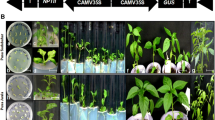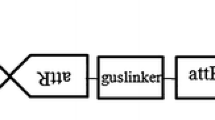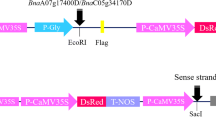Abstract
Rapeseed (Brassica napus) is an important oil crop that supplies a considerable amount of global vegetable oil production. Genetic transformation system is important to gene functional analysis and molecular breeding. Here, an efficient Agrobacterium-mediated transformation protocol using hypocotyl of rapeseed as explants is described. To develop this protocol, we compared several essential factors that would affect the transformation efficiency, such as Agrobacterium strains, selection marker genes, and genotypes of rapeseed. Comparison of different Agrobacterium strains showed that the GV3101 had higher transformation efficiency than that of C58C1 and EHA105. HPTII, NPTII, and RePAT were used as selection marker genes in tissue culture. The results showed that the transformation efficiency was 3.7–4.8%, 2.2–22.5%, and 1.6–5.9% when the hypocotyl of Westar was infected by GV3101 and screened under hygromycin, kanamycin, and basta, respectively. The transformation efficiency of Westar was the highest and ZS11 was the lowest when five different genotypes of rapeseed (Westar, ZS9, ZS11, GY284, and WH3417) were infected by GV3101. Using this protocol, it will take 8–10 weeks to obtain transgenic plants. This protocol has been used to study gene function in several genotypes of rapeseed in our laboratory. These results indicate that it is efficient to obtain transgenic plant of rapeseed using this protocol.




Similar content being viewed by others
References
Berg DE, Davies J, Allet B, Rochaix JD (1975) Transposition of R factor genes to bacteriophage lambda. Proc Natl Acad Sci U S A 72(9):3628–3632. https://doi.org/10.1073/pnas.72.9.3628
Bergman P, Glimelius K (1993) Electroporation of rapeseed protoplasts – transient and stable transformation. 88(4):604–611. https://doi.org/10.1111/j.1399-3054.1993.tb01378.x
Bhalla PL, Singh MB (2008) Agrobacterium-mediated transformation of Brassica napus and Brassica oleracea. Nat Protoc 3(2):181–189. https://doi.org/10.1038/nprot.2007.527
Chalhoub B, Denoeud F, Liu S, Parkin IA, Tang H, Wang X, Chiquet J, Belcram H, Tong C, Samans B, Correa M, Da Silva C, Just J, Falentin C, Koh CS, Le Clainche I, Bernard M, Bento P, Noel B, Labadie K, Alberti A, Charles M, Arnaud D, Guo H, Daviaud C, Alamery S, Jabbari K, Zhao M, Edger PP, Chelaifa H, Tack D, Lassalle G, Mestiri I, Schnel N, Le Paslier MC, Fan G, Renault V, Bayer PE, Golicz AA, Manoli S, Lee TH, Thi VH, Chalabi S, Hu Q, Fan C, Tollenaere R, Lu Y, Battail C, Shen J, Sidebottom CH, Wang X, Canaguier A, Chauveau A, Berard A, Deniot G, Guan M, Liu Z, Sun F, Lim YP, Lyons E, Town CD, Bancroft I, Wang X, Meng J, Ma J, Pires JC, King GJ, Brunel D, Delourme R, Renard M, Aury JM, Adams KL, Batley J, Snowdon RJ, Tost J, Edwards D, Zhou Y, Hua W, Sharpe AG, Paterson AH, Guan C, Wincker P (2014) Plant genetics. Early allopolyploid evolution in the post-Neolithic Brassica napus oilseed genome. Science 345(6199):950–953. https://doi.org/10.1126/science.1253435
Clough SJ, Bent AF (1998) Floral dip: a simplified method for Agrobacterium-mediated transformation of Arabidopsis thaliana. Plant J 16(6):735–743. https://doi.org/10.1046/j.1365-313x.1998.00343.x
Cui Y, Liu Z, Li Y, Zhou F, Chen H, Lin Y (2016) Application of a novel phosphinothricin N-acetyltransferase (RePAT) gene in developing glufosinate-resistant rice. Sci Rep 6:21259–21259. https://doi.org/10.1038/srep21259
Curtis MD, Grossniklaus U (2003) A gateway cloning vector set for high-throughput functional analysis of genes in planta. Plant Physiol 133(2):462–469. https://doi.org/10.1104/pp.103.027979
Davey MR, Anthony P, Power JB, Lowe KC (2005) Plant protoplasts: status and biotechnological perspectives. Biotechnol Adv 23(2):131–171. https://doi.org/10.1016/j.biotechadv.2004.09.008
Davey MR, Soneji JR, Rao MN, Kourmpetli S, Bhattacharya A, Kole C (2010) Generation and deployment of transgenic crop plants: an overview. In: Kole C, Michler CH, Abbott AG, Hall TC (eds) Transgenic crop plants: principles and development. Springer, Berlin Heidelberg, pp 1–29. https://doi.org/10.1007/978-3-642-04809-8_1
Donn G, Köcher H (2002) Inhibitors of glutamine synthetase. In pp 87–101. https://doi.org/10.1007/978-3-642-59416-8_4
Eimert K, Siegemund F (1992) Transformation of cauliflower (Brassica oleracea L. var. botrytis)--an experimental survey. Plant Mol Biol 19(3):485–490. https://doi.org/10.1007/BF00023396
Gracka A, Jelen HH, Majcher M, Siger A, Kaczmarek A (2016) Flavoromics approach in monitoring changes in volatile compounds of virgin rapeseed oil caused by seed roasting. J Chromatogr A 1428:292–304. https://doi.org/10.1016/j.chroma.2015.10.088
Gritz L, Davies J (1983) Plasmid-encoded hygromycin B resistance: the sequence of hygromycin B phosphotransferase gene and its expression in Escherichia coli and Saccharomyces cerevisiae. Gene 25(2–3):179–188. https://doi.org/10.1016/0378-1119(83)90223-8
Hansen LN, Ortiz R, Andersen SB (1999) Genetic analysis of protoplast regeneration ability in Brassica oleracea. Plant Cell Tissue Organ Cult 58(2):127–132. https://doi.org/10.1023/A:1006359804328
Herrera-Estrella L, Simpson J, Martínez-Trujillo M (2004) Transgenic plants: an historical perspective. In: Peña L (ed) Transgenic plants: methods and protocols. Humana Press, Totowa, pp 3–31. https://doi.org/10.1385/1-59259-827-7:003
Hong Y, Pan X, Welti R, Wang X (2008) Phospholipase Dalpha3 is involved in the hyperosmotic response in Arabidopsis. Plant Cell 20(3):803–816. https://doi.org/10.1105/tpc.107.056390
Ishida Y, Hiei Y, Komari T (2007) Agrobacterium-mediated transformation of maize. Nat Protoc 2(7):1614–1621. https://doi.org/10.1038/nprot.2007.241
Kikkert JR, Vidal JR, Reisch BI (2005) Stable transformation of plant cells by particle bombardment/biolistics. Methods Mol Biol 286:61–78. https://doi.org/10.1385/1-59259-827-7:061
Lu S, Bahn SC, Qu G, Qin H, Hong Y, Xu Q, Zhou Y, Hong Y, Wang X (2013) Increased expression of phospholipase Dalpha1 in guard cells decreases water loss with improved seed production under drought in Brassica napus. Plant Biotechnol J 11(3):380–389. https://doi.org/10.1111/pbi.12028
Lu S, Fadlalla T, Tang S, Li L, Ali U, Li Q, Guo L (2019) Genome-wide analysis of phospholipase D gene family and profiling of phospholipids under abiotic stresses in Brassica napus. Plant Cell Physiol 60:1556–1566. https://doi.org/10.1093/pcp/pcz071
Lu S, Yao S, Wang G, Guo L, Zhou Y, Hong Y, Wang X (2016) Phospholipase Depsilon enhances Braasca napus growth and seed production in response to nitrogen availability. Plant Biotechnol J 14(3):926–937. https://doi.org/10.1111/pbi.12446
Mason AS, Snowdon RJ (2016) Oilseed rape: learning about ancient and recent polyploid evolution from a recent crop species. Plant Biol (Stuttg) 18(6):883–892. https://doi.org/10.1111/plb.12462
Mukhopadhyay A, Topfer R, Pradhan AK, Sodhi YS, Steinbiss HH, Schell J, Pental D (1991) Efficient regeneration of Brassica oleracea hypocotyl protoplasts and high frequency genetic transformation by direct DNA uptake. Plant Cell Rep 10(8):375–379. https://doi.org/10.1007/BF00232604
Ono Y, Takahata Y, Kaizuma N (1994) Effect of genotype on shoot regeneration from cotyledonary explants of rapeseed (Brassica napus L.). Plant Cell Rep 14(1):13–17. https://doi.org/10.1007/BF00233290
Poulsen GB (1996) Genetic transformation of Brassica. Plant Breed 115(4):209–225. https://doi.org/10.1111/j.1439-0523.1996.tb00907.x
Radchuk VV, Ryschka U, Schumann G, Klocke E (2002) Genetic transformation of cauliflower (Brassica oleracea var. botrytis) by direct DNA uptake into mesophyll protoplasts. Physiol Plant 114(3):429–438. https://doi.org/10.1034/j.1399-3054.2002.1140313.x
Rahman H, Bennett RA, Kebede B (2017) Mapping of days to flower and seed yield in spring oilseed Brassica napus carrying genome content introgressed from Brassica oleracea. Mol Breed 37(1). https://doi.org/10.1007/s11032-016-0608-2
Raineri DM, Bottino P, Gordon MP, Nester EW (1990) Agrobacterium–mediated transformation of rice (Oryza sativa L.). Nat Biotechnol 8(1):33–38. https://doi.org/10.1038/nbt0190-33
Rani T, Yadav R, Yadav N, Rani A, Singh D (2013) Genetic transformation in oilseed brassicas -a review. Indian J Agric Sci 83(4):367–373
Sitther V, Tabatabai B, Enitan O, Dhekney S (2018) Agrobacterium-mediated transformation of Camelina sativa for production of transgenic plants. J Biol Methods 5(1):e83. https://doi.org/10.14440/jbm.2018.208
Tang T, Yu X, Yang H, Gao Q, Ji H, Wang Y, Yan G, Peng Y, Luo H, Liu K, Li X, Ma C, Kang C, Dai C (2018) Development and validation of an effective CRISPR/Cas9 vector for efficiently isolating positive transformants and transgene-free mutants in a wide range of plant species. Front Plant Sci 9:1533. https://doi.org/10.3389/fpls.2018.01533
Tzfira T, Citovsky V (2006) Agrobacterium-mediated genetic transformation of plants: biology and biotechnology. Curr Opin Biotechnol 17(2):147–154. https://doi.org/10.1016/j.copbio.2006.01.009
Verma S, Chinnusamy V, Kc B (2008) A simplified floral dip method for transformation of Brassica napus and B. carinata. J Plant Biochem Biotechnol 17:197–200. https://doi.org/10.1007/BF03263286
Xing HL, Dong L, Wang ZP, Zhang HY, Han CY, Liu B, Wang XC, Chen QJ (2014) A CRISPR/Cas9 toolkit for multiplex genome editing in plants. BMC Plant Biol 14:327. https://doi.org/10.1186/s12870-014-0327-y
Yang H, Wu JJ, Tang T, Liu KD, Dai C (2017) CRISPR/Cas9-mediated genome editing efficiently creates specific mutations at multiple loci using one sgRNA in Brassica napus. Sci Rep 7(1):7489. https://doi.org/10.1038/s41598-017-07871-9
Yoo S-D, Cho Y-H, Sheen J (2007) Arabidopsis mesophyll protoplasts: a versatile cell system for transient gene expression analysis. Nat Protoc 2(7):1565–1572. https://doi.org/10.1038/nprot.2007.199
Yu B, Boyle K, Zhang W, Robinson SJ, Higgins E, Ehman L, Relf-Eckstein J-A, Rakow G, Parkin IAP, Sharpe AG, Fobert PR (2016) Multi-trait and multi-environment QTL analysis reveals the impact of seed colour on seed composition traits in Brassica napus. Mol Breed 36(8). https://doi.org/10.1007/s11032-016-0521-8
Zhang K, He J, Liu L, Xie R, Qiu L, Li X, Yuan W, Chen K, Yin Y, Kyaw MMM, San AA, Li S, Tang X, Fu C, Li M (2020) A convenient, rapid and efficient method for establishing transgenic lines of Brassica napus. Plant Methods 16:43. https://doi.org/10.1186/s13007-020-00585-6
Zhang Y, Singh MB, Swoboda I, Bhalla PL (2005) Agrobacterium-mediated transformation and generation of male sterile lines of Australian canola. Aust J Agric Res 56(4):353. https://doi.org/10.1071/ar04175
Acknowledgments
We are grateful to Prof. Qijun Chen at China Agricultural University for kindly providing pKSE401 and pCBC-DT1T2 vectors for constructing CRISPR/Cas9 system.
Funding
This study was supported by the National Program of Transgenic Variety Development of China (2018ZX08020-001), the National Natural Science Foundation of China (31701458), the Fundamental Research Funds for the Central Universities (2662018QD064), and the China Postdoctoral Science Foundation (2015M580651, 2016T90704).
Author information
Authors and Affiliations
Contributions
SP.L., C.D., and L.G. designed the research. YQ. L, L.L, ZL.D., SL. L., X.T., SJ. L., B.Y., W.Y., and J.W. performed the experiments. SP.L., and C.D. analyzed the data. C.D. and SP.L. wrote the manuscript. L.G. revised the manuscript. All authors read and approved the manuscript.
Corresponding authors
Ethics declarations
Competing interests
The authors declare that they have no conflict of interest.
Additional information
Publisher’s note
Springer Nature remains neutral with regard to jurisdictional claims in published maps and institutional affiliations.
Rights and permissions
About this article
Cite this article
Dai, C., Li, Y., Li, L. et al. An efficient Agrobacterium-mediated transformation method using hypocotyl as explants for Brassica napus. Mol Breeding 40, 96 (2020). https://doi.org/10.1007/s11032-020-01174-0
Received:
Accepted:
Published:
DOI: https://doi.org/10.1007/s11032-020-01174-0




